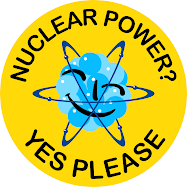Mike Townsley of Greenpeace International said another important reason to steer clear of nuclear power is its cost. Despite early promises that nuclear reactors would produce electricity too cheap to meter, Townsley said that the only plants under construction in Europe were receiving public subsidies.
"Nuclear power fails the market test and the carbon test, as in many cases both renewable energy sources and energy efficiency can deliver more for less," he said.
From the UOW Nukeweb's Nuclear vs. Coal Analysis
In Romania, a unit is now being completed, but only with a low-cost loan, said Townsley. in Finland, a French project is being investigated by European regulators for unlawful subsidies, he said, while in the United States much of the interest in nuclear power is because of energy legislation promising large tax breaks for new reactors.
Right.... so if I just page down a bit further on the Green page, I find an article on Denmark's wind poower. [NB Denmark has no nuclear power plants].
If a heavy reliance on fossil fuels makes a country a climate ogre, then Denmark — with its thousands of wind turbines sprinkled on the coastlines and at sea — is living a happy fairy tale.
But a closer look shows that Denmark is a far cry from a clean-energy paradise.The building of wind turbines has virtually ground to a halt since subsidies were cut back. Meanwhile, compared with others in the European Union, Danes remain above-average emitters of the greenhouse gas carbon dioxide. For all its wind turbines, a large proportion of the rest of Denmark's power is generated by plants that burn imported coal.
The Danish experience shows how difficult it can be for countries grown rich on fossil fuels to switch to renewable energy sources like wind power.
If higher subsidies had been maintained, he [Preben Maegaard, the executive director of the Nordic Folkecenter for Renewable Energy, a non-profit group] said, Denmark could now be generating close to one-third — rather than one-fifth — of its electricity from windmills.
Besides political hiccups, there have been technical setbacks, as Danish wind operators, hoping to bypass local objections and take advantage of stronger, steadier air currents, have tried to build giant turbines at sea. In one case, in 2004, turbines at Horns Reef, some 10 miles off the Danish coast, broke down, their critical equipment damaged by storms and salt water.
Vestas, a Danish manufacturer, fixed the problem by replacing the equipment at a cost of €38 million, or [US] $50 million. But Peter Kruse, the head of investor relations for Vestas, warned that the lesson from Horns Reef was that wind farms at sea would remain far more expensive than those on land.
"Offshore wind farms don't destroy your landscape," Kruse said, but the added installation and maintenance costs were "going to be very disappointing for many politicians across the world."
So which is it? Should government subsidies be used to offset emissions? And if so, shouldn't their use be optimised?
Please don't take this post the wrong way. I do not wish to set up some sort of renewables vs. nuclear comparison, only highlight the dichotomy of the current enviro-political struggles.
















No comments:
Post a Comment